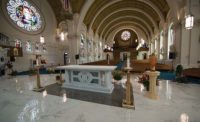
D’Espresso is a New York City espresso bar that
conceptually and literally turned into a sideways library with the use of
custom tiles. Drawing its inspiration from the nearby Bryant Public Library,
nemaworkshop sought to design a store that would be straightforward in a
simple, but warped way. Designer: nemaworkshop, New York, NY; Tile
Manufacturer/Supplier: Imagine Tile, New York, NY
Located on Madison Avenue in the heart of New York City, D’Espresso offers its customers an out of the ordinary environment as they grab their daily coffee. While creating a striking identity for the emerging brand, the espresso bar conceptually and literally turns a normal room sideways with the use of custom tiles manufactured by Imagine Tile of New York, NY.
The designer, Anurag Nema, owner of nemaworkshop in New York, NY, explained that his overall design goal for this project was to give an identity to the emerging brand. The owner of D’Espresso approached nemaworkshop with an ambition to build a unique espresso brand and to develop a creative environment that would connect it to its location.
“It was really important that the design was contextual and yet still receptive to future locations,” Nema said. Drawing its inspiration from the nearby Bryant Public Library, nemaworkshop sought to design a store that would be straightforward in a simple, but warped way.
According to the designer, the client was very involved in the design process. “Our client knew that he wanted something which was bold and fresh, but aside from that, he gave us a lot of liberty,” said Nema. “We presented some radical ideas to him and fortunately he was supportive and enthusiastic. It is extremely fun for us when the client is excited about design, and unafraid of bold ideas.”
Nema decided to design the store as if it was a library turned sideways. He envisioned creating a book-lined oasis that he could turn onto its side so that the bookshelves would become the floor and ceiling. In addition, he wanted the floor to become a wall, and the lights on the “ceiling” to protrude horizontally out from the wall behind the counter. In making this possible, nemaworkshop worked closely with Imagine Tile’s owner, Christian McAuley.

The owner of D’Espresso approached nemaworkshop with
an ambition to build a unique espresso brand and to develop a creative
environment that would connect it to its location.
Creating the tile
To create the most striking feature of the 420-square-foot space, Nema and McAuley pieced a bookcase together with tiles. With three tiled surfaces - the floor, one wall and the ceiling - the material continuity was crucial to the design.“We organized a photo shoot at a travel bookshop in New York, and sent the photographs to Imagine Tile,” said the designer. “First, we were brought a full-scale mock-up of the print on foam core, and then we went through a series of tile mock-ups, finely tuning the contrast and color of the tile.”
According to Nema, the most challenging part of the tile work was nailing the color and contrast. “Because the tiles were custom, we were actually starting from scratch,” he explained. “We went through several iterations before we had the image exactly where we wanted it.”
Imagine Tile had to alter the image to make it a “sepia tone,” and also matched the darker brown color to a paint sample that nemaworkshop supplied. The tiles were all screen printed, and the image was glazed onto the tile.
According to McAuley, the image created was made up of 18 different 16- x 16-inch tiles, manufactured in their own plant, which repeated 36 times across the surface. Developed in collaboration with nemaworkshop, the custom tiles run along the floor, up the 15-foot wall and across the ceiling.
Since ceramic glazes were being used, nemaworkshop requested a very abrasive finish in order to give the tiles a soft matte look and feel as well as to create an anti-slip surface for the floor.

To create the most striking feature of the
420-square-foot space, a bookcase was pieced together with tiles. With three
tiled surfaces - the floor, one wall and the ceiling - the material continuity
was crucial to the design.
Accomplishing the vision
In addition to the design, budget was also taken into consideration when working on the project. “The main challenge in creating this project was finding a way to create a pattern that repeated, but that did not appear to repeat,” said McAuley. “We worked closely with nemaworkshop in order to develop a system that would lower cost without compromising the overall design and quality.”A process that usually takes anywhere from eight to 12 weeks, making customized tiles includes proofing and production, which varies from different quantities. During the process, Imagine Tile supplied several different versions of gloss level form for options of a very matte looking surface, and had to match an exact chip color that was given to them.
The size of the shop also presented a small challenge. “Since the shop is small, we had to arrange a delivery system that only allowed the delivery of a certain amount of material at a time,” said McAuley. “We shipped the first and second half separately to the East Coast, held it in a warehouse, and delivered it in about three parts.
“However, we worked with nemaworkshop as we would with most of our designers,” McAuley went on to say. “Everyone has a specific set of needs, and we work within them to make sure that everything is accomplished efficiently and effectively.”
Completed in early September, the project took less than a year to finish, and has been very well received internationally. Going viral on the Internet, spreading through design blogs and Web-and print-based publications, and being featured on ABC News proves that people are very excited about the project. “Nemaworkshop is an innovative firm with a creative vision and the know-how to bring that vision to reality,” McAuley said. “We truly enjoyed working with them on this project, and we are very happy with the final product.”

The designer envisioned creating a book-lined oasis
that he could turn onto its side so that the bookshelves would become the floor
and ceiling.

The image created was made up of 18 different 16- x
16-inch tiles, which repeated 36 times across the surface. The custom tiles run
along the floor, up the 15-foot wall and across the ceiling.

